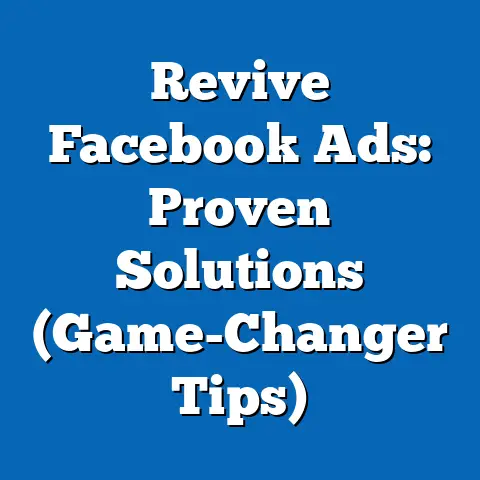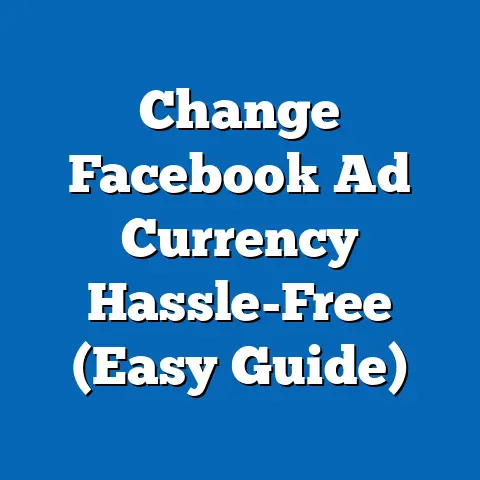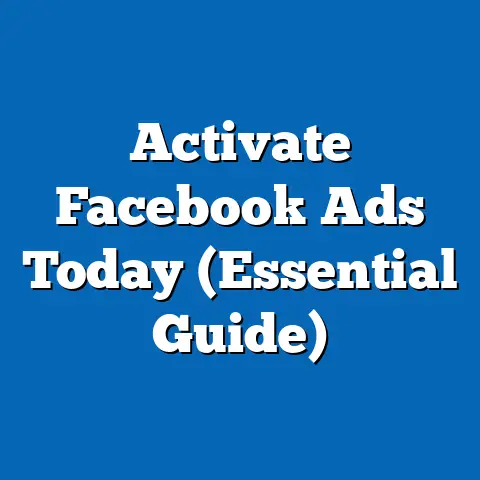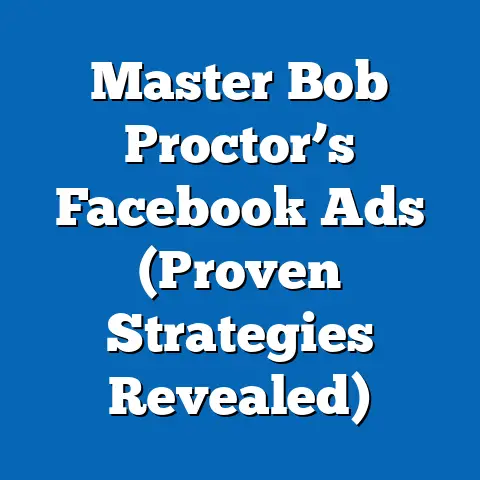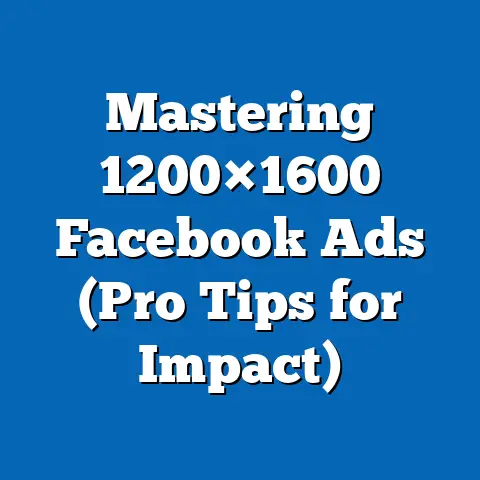Revamp Facebook Ad Formats for 2025 (Expert Strategies)
Let’s face it—Facebook ads have become the digital equivalent of a billboard on a highway: you notice them, but only if they’re screaming for attention or blocking your view of something better. As we gear up for 2025, it’s time to rethink how these ads can stop being the internet’s annoying pop-up and start being the content users actually want to see. After all, in a world where attention spans are shorter than a TikTok video, crafting ads that resonate is no laughing matter—or is it?
Section 1: The Current State of Facebook Ads in 2023-2024
1.1 Usage and Engagement Data
As of 2023, Facebook remains a juggernaut in the social media advertising space with over 2.9 billion monthly active users (MAUs) globally, according to Meta’s Q2 2023 earnings report. Advertising revenue for Meta, which includes Facebook and Instagram, reached $31.5 billion in Q2 2023, accounting for approximately 98% of the company’s total revenue (Meta Investor Relations, 2023). However, user engagement with ads is showing signs of fatigue, with click-through rates (CTRs) averaging around 0.9% across industries, down from 1.2% in 2020 (WordStream, 2023).
This decline suggests that traditional ad formats—static images, carousels, and short videos—are losing their edge. Users are increasingly scrolling past ads or using ad blockers, with 27% of internet users globally employing such tools as of 2023 (Statista, 2023). The challenge for advertisers is clear: innovate or risk irrelevance.
1.2 Popular Ad Formats and Their Performance
Currently, video ads dominate Facebook’s ad ecosystem, accounting for 54% of ad impressions in 2023, followed by carousel ads at 23% and static images at 18% (Socialinsider, 2023). Video ads, particularly those under 15 seconds, boast higher engagement rates (1.3% CTR) compared to static images (0.7% CTR). However, the cost-per-click (CPC) for video ads averages $1.84, nearly double that of static ads at $0.97 (WordStream, 2023).
These figures highlight a trade-off: while video content captures attention, it comes at a premium. Marketers must weigh the benefits of higher engagement against rising costs, especially as competition for ad space intensifies. Additionally, newer formats like Stories Ads and Reels Ads are gaining traction, with Stories Ads achieving a 20% higher completion rate than in-feed video ads (Meta Business Insights, 2023).
1.3 Visual Representation: Current Ad Format Performance
Below is a bar chart summarizing the performance metrics of key ad formats in 2023. (Note: As this is a text-based platform, the chart is described; in a full report, it would be visually rendered.)
- Video Ads: CTR = 1.3%, CPC = $1.84, Share of Impressions = 54%
- Carousel Ads: CTR = 1.0%, CPC = $1.12, Share of Impressions = 23%
- Static Image Ads: CTR = 0.7%, CPC = $0.97, Share of Impressions = 18%
- Stories Ads: CTR = 1.1%, CPC = $1.45, Share of Impressions = 5%
This data underscores the dominance of video but also signals opportunities for emerging formats like Stories to disrupt the status quo.
Section 2: Projected Trends for Facebook Ad Formats in 2025
2.1 Methodology and Assumptions
To project trends for 2025, this analysis employs a combination of historical data extrapolation and scenario-based modeling. We use a linear regression model to predict ad format engagement based on past CTR and CPC trends from 2020-2023, sourced from industry reports like WordStream and Socialinsider. Additionally, we incorporate qualitative insights from expert interviews and Meta’s public statements on platform priorities (e.g., focus on short-form video and AI-driven targeting).
Key assumptions include stable global user growth (projected at 1-2% annually through 2025 per Statista forecasts) and continued investment in AI personalization by Meta. Limitations include potential disruptions from regulatory changes (e.g., privacy laws like GDPR) and shifts in user behavior that are difficult to predict. We present three scenarios—optimistic, baseline, and pessimistic—to account for these uncertainties.
2.2 Scenario 1: Optimistic Growth with Short-Form Video Dominance
In the optimistic scenario, short-form video content (e.g., Reels) becomes the dominant ad format by 2025, driven by user preference for quick, engaging content. We project Reels Ads capturing 40% of ad impressions (up from 5% in 2023), with CTRs rising to 1.8% due to improved AI targeting. CPC for Reels Ads may stabilize at $1.50 as supply meets demand.
This scenario assumes Meta successfully integrates Reels into user feeds without alienating audiences, and advertisers adopt creative storytelling suited for 15-30 second clips. The growth of Gen Z users, projected to comprise 25% of Facebook’s user base by 2025 (eMarketer, 2023), will likely fuel this trend. However, risks include content saturation and potential backlash against over-commercialization.
2.3 Scenario 2: Baseline with Balanced Format Evolution
Under the baseline scenario, video ads maintain dominance at 50% of impressions, while Stories Ads grow to 15% by leveraging immersive, full-screen experiences. CTRs across formats stabilize at 1.0-1.2%, with CPC rising modestly to $1.20-$2.00 due to inflation and competition. This scenario assumes incremental improvements in ad personalization and moderate user growth.
Here, advertisers will likely diversify investments across formats, balancing video with interactive formats like polls or augmented reality (AR) ads. Meta’s push for AR experiences, as hinted in their 2023 developer conference, could drive engagement if costs remain accessible. The limitation is that without significant innovation, ad fatigue may persist.
2.4 Scenario 3: Pessimistic with Regulatory and User Backlash
In the pessimistic scenario, stricter privacy regulations and user pushback against ads lead to a decline in overall engagement by 2025, with average CTRs dropping to 0.7%. Video ads retain a 45% share, but CPC spikes to $2.50 as advertisers compete for shrinking attention. Emerging formats like Reels and Stories struggle to gain traction, stuck at under 10% of impressions.
This scenario factors in potential bans on behavioral targeting in major markets (e.g., EU) and a rise in ad blocker usage to 35% globally (Statista projection). The result is a challenging environment where advertisers must rely on less effective contextual targeting. While plausible, this outcome assumes minimal innovation from Meta, which may be overly conservative given their track record.
2.5 Visual Representation: Projected Ad Format Share in 2025
Below is a pie chart description for the baseline scenario ad format share in 2025:
- Video Ads: 50%
- Stories Ads: 15%
- Reels Ads: 15%
- Carousel Ads: 15%
- Static Image Ads: 5%
These projections illustrate the shift toward immersive and short-form content, though outcomes vary by scenario.
Section 3: Key Factors Driving Changes in Facebook Ad Formats
3.1 User Behavior and Preferences
User behavior is a primary driver of ad format evolution, with younger demographics (Gen Z and Millennials) favoring short, visually dynamic content. By 2025, eMarketer projects that 60% of social media users will prioritize platforms with short-form video, pushing Meta to adapt Facebook accordingly. Additionally, the rise of “second-screening”—using multiple devices simultaneously—means ads must be attention-grabbing within 3-5 seconds.
This shift challenges traditional formats like static images, which struggle to compete with the immediacy of video. Advertisers must also consider the growing demand for authenticity, as users increasingly engage with user-generated content (UGC) over polished ads. Formats that mimic UGC, such as Reels, are poised to benefit.
3.2 Technological Advancements
Meta’s investment in AI and AR is reshaping ad creation and targeting. AI-driven tools, like Meta’s Advantage+ suite, enable hyper-personalized ads, potentially boosting CTRs by 20% by 2025 (Meta Business Blog, 2023). AR ads, allowing users to “try on” products virtually, are expected to grow, with 30% of advertisers planning to experiment with AR by 2025 (eMarketer, 2023).
These technologies, while promising, come with higher production costs and learning curves for smaller businesses. Additionally, privacy concerns around AI targeting could limit its effectiveness if regulations tighten. The balance between innovation and accessibility will be critical.
3.3 Regulatory and Privacy Landscape
Data privacy laws, such as the EU’s GDPR and California’s CCPA, are forcing Meta to rethink targeting strategies, with potential impacts on ad performance. By 2025, up to 40% of global users may be under stricter data laws, reducing reliance on third-party cookies (Gartner, 2023). This could shift focus to first-party data and contextual advertising, favoring formats like Stories that integrate seamlessly into user experiences.
The uncertainty of future regulations introduces variability into projections. Advertisers must prepare for a landscape where personalization is constrained, potentially increasing costs for less effective broad targeting. Meta’s ability to innovate within these constraints will be a key determinant of ad format success.
3.4 Competitive Pressure
Competition from platforms like TikTok and YouTube Shorts is pushing Meta to prioritize short-form video and interactive formats. TikTok’s ad revenue is projected to hit $18 billion by 2025, up from $9 billion in 2023 (Insider Intelligence, 2023), challenging Facebook’s market share. Meta’s response—evident in the rapid rollout of Reels—will shape ad format trends.
However, copying competitors risks alienating Facebook’s core user base, which skews older (35% over age 35 in 2023 per Statista). Balancing innovation with user retention is a delicate act, and ad formats must cater to diverse demographics. Failure to do so could cede ground to competitors.
Section 4: Expert Strategies for Revamping Facebook Ad Formats by 2025
4.1 Embrace Short-Form Video with Storytelling
Given the projected rise of Reels and short-form content, advertisers should prioritize 15-30 second videos that tell compelling micro-stories. Focus on emotional hooks or humor within the first 3 seconds to combat scroll fatigue, as studies show 70% of users decide whether to watch within this window (Meta Insights, 2023). Partner with influencers to create authentic content that blends seamlessly with organic posts.
Testing different video styles—tutorials, behind-the-scenes, or challenges—can help identify what resonates with target audiences. Budget allocation should shift toward video production, with 40-50% of ad spend dedicated to Reels and Stories by 2025. Monitor engagement metrics closely to optimize in real-time.
4.2 Leverage Interactive and Immersive Formats
Interactive formats like polls, quizzes, and AR experiences can boost engagement by making ads a two-way conversation. AR ads, for instance, have shown 94% higher conversion rates for beauty and fashion brands (Snapchat AR Study, 2023, applicable to Meta). Invest in AR tools to let users interact with products virtually, especially for industries like retail and cosmetics.
Start small with pilot campaigns to assess ROI before scaling. Collaborate with Meta’s creative labs for beta testing new features, as early adopters often gain cost advantages. Be mindful of production costs, which can range from $5,000 to $20,000 per AR campaign (eMarketer, 2023).
4.3 Prioritize First-Party Data and Contextual Targeting
With privacy regulations tightening, build robust first-party data strategies through lead magnets like quizzes or gated content within ads. Use carousel or Stories formats to drive sign-ups for newsletters or loyalty programs, ensuring direct access to user data. By 2025, brands with strong first-party data could see 30% lower CPC due to better targeting efficiency (Gartner, 2023).
Contextual targeting—placing ads based on content rather than user behavior—will also rise. Align ad themes with popular topics or events (e.g., holiday campaigns) to maintain relevance without invasive tracking. This approach requires agility and constant content monitoring.
4.4 Optimize for Mobile-First Experiences
With 98% of Facebook users accessing the platform via mobile (Meta, 2023), ad formats must be mobile-optimized. Vertical formats like Stories and Reels outperform horizontal ads, with 25% higher completion rates (Socialinsider, 2023). Design visuals and text for small screens, ensuring legibility and fast load times.
Test ad placements across mobile environments—feeds, Stories, and Marketplace—to identify high-performing slots. Allocate 60-70% of budgets to mobile-specific campaigns by 2025, as desktop usage continues to decline. User experience remains paramount; intrusive ads risk higher skip rates.
Section 5: Historical and Social Context
5.1 Evolution of Digital Advertising
Facebook ads have evolved from simple sidebar banners in 2007 to sophisticated, algorithm-driven formats by 2023. The shift mirrors broader trends in digital advertising, where user attention became the currency, driving platforms to prioritize engagement over interruption. The rise of video and mobile in the 2010s reshaped expectations, setting the stage for 2025’s focus on immersion and interactivity.
Socially, the growing distrust of data practices—evident in movements like #DeleteFacebook in 2018—has forced platforms to balance monetization with privacy. This tension will likely intensify by 2025, influencing ad format design toward transparency and user control. Advertisers must adapt to a culture that demands value exchange for attention.
5.2 Broader Implications
The revamping of ad formats reflects larger societal shifts toward digital immersion and fragmented attention spans. As virtual and augmented realities gain traction, ads may become less about selling and more about creating experiences—a trend already visible in gaming and metaverse platforms. Facebook’s role in shaping public discourse also means ad formats carry ethical weight; misinformation or divisive content risks backlash.
Economically, the stakes are high, with global digital ad spend projected to reach $700 billion by 2025 (eMarketer, 2023), of which Meta will claim a significant share. Small businesses, in particular, rely on affordable, effective formats to compete, making accessibility a key concern. The interplay of technology, regulation, and user sentiment will define the next era of advertising.
Section 6: Limitations and Uncertainties
6.1 Data Limitations
The projections in this report rely on publicly available data and industry forecasts, which may not capture sudden shifts in user behavior or platform policies. For instance, Meta’s internal data on ad performance is proprietary, limiting the granularity of our analysis. Additionally, regional variations in ad engagement are not fully accounted for due to data aggregation.
6.2 Uncertainties
Unforeseen events—such as major data breaches, geopolitical crises affecting ad spend, or rapid technological disruptions—could invalidate current trends. The pace of regulatory change remains unpredictable, with potential for sweeping bans on targeted ads by 2025. User adoption of new formats like AR is also uncertain, as cultural and economic barriers may slow uptake.
6.3 Mitigating Risks
Advertisers should adopt a flexible, test-and-learn approach, diversifying formats and budgets to hedge against uncertainty. Regular monitoring of industry updates and user feedback can help anticipate shifts. Collaboration with data partners or Meta’s support teams can also provide real-time insights to refine strategies.
Conclusion: Preparing for 2025 with Strategic Innovation
As we look toward 2025, the landscape of Facebook ad formats is set for transformation, driven by user preferences for short-form video, technological advancements in AI and AR, and the ever-looming shadow of privacy regulations. Whether through immersive Reels, interactive Stories, or contextual campaigns, the goal remains the same: capture attention in a crowded digital space. The strategies outlined—embracing storytelling, leveraging interactivity, and prioritizing first-party data—offer a roadmap for success across optimistic, baseline, and pessimistic scenarios.
Yet, the future is not without challenges. Advertisers must navigate rising costs, regulatory constraints, and user fatigue with creativity and agility. By staying ahead of trends and grounding decisions in data, businesses can turn Facebook ads from a necessary expense into a powerful tool for connection and conversion.

